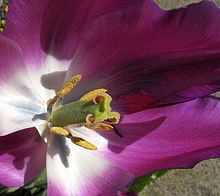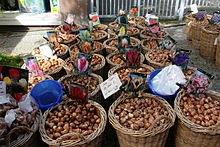Tulips
| Tulips | ||||||||||||
|---|---|---|---|---|---|---|---|---|---|---|---|---|
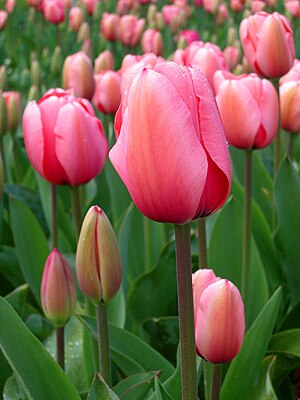
Tulips |
||||||||||||
| Systematics | ||||||||||||
|
||||||||||||
| Scientific name | ||||||||||||
| Tulipa | ||||||||||||
| L. |
The tulips ( Tulipa ) constitute a genus within the family of Liliaceae (Liliaceae). The approximately 150 species are distributed in North Africa and across Europe to Central Asia. Numerous hybrids are used as ornamental plants in parks and gardens and as cut flowers.
Naming
Your name goes on Turkish tülbend in Persian دلبند/ delband and means in Persian "lover" ("del" / دل = heart; "band" from "bastan" بستن = (to) bind). The origin of the first syllable can be traced back to the Sanskrit word तूल / tūla , which is translated as "cotton". In Persian the genus is called Lale (لاله/ lāle ) denotes what is etymologically related to Sanskrit (cf. hind. लाल / lāl - "red"). In Turkish itself the flower is also called lale , which is a borrowing from Persian.
description


Appearance and leaves
Tulip species grow as perennial , herbaceous plants and, depending on the species, reach heights of 10 to 70 centimeters. These geophytes develop onions as persistent organs. The outer skin of the onions is usually hairy on the inside. The lower part of the mostly unbranched stem is in the ground.
A tulip bulb dies after flowering, at the same time a new flowering bulb develops in the armpit of an onion scale and weaker bulbs grow at the base of the remaining onion scales.
Most of the leaves are basal and up to 30 centimeters long. The mostly two to six, rarely up to twelve alternately arranged leaves are sessile. The simple leaf blades are broadly linear to almost ovoid. The leaf margin is smooth to wavy (for example Tulipa undulatifolia ).
Inflorescences and flowers
Depending on the cultivated form, the flower color varies from white, yellow, orange, pink, red to blue and even black. The flowers are usually solitary and terminal or in little-flowered inflorescences. Bracts are usually missing. The upright flowers are hermaphroditic, threefold and bell- to cup-shaped. There are two circles of free bracts , the bracts of the two circles being more or less differently shaped. There are two circles with three free, fertile stamens each; they are either the same or those of the inner circle are longer. The stamens are sometimes hairy. Three carpels have become a top permanent ovary grown, with many ovules . The columnar or very short to absent stylus ends in a three-lobed stigma .

Fruits and seeds
A cylindrical to spindle-shaped, three-winged, leathery, three-chamber capsule fruit is formed. The seeds are mostly flat.
Special features of some varieties
The striped or spotted flowers that are occasionally seen are often caused by a mosaic virus . However, there are also a number of varieties (for example 'Insulinde', 'Zomerschoon') whose striped flowers cannot be traced back to a virus infection.
Systematics and distribution
The genus Tulipa was established by Carl von Linné . Synonyms for Tulipa L. are: Orithyia D.Don , Liriactis Raf. , Liriopogon Raf. , Podonix Raf. , Eduardoregelia Popov .
Internal system
The area with the highest biodiversity of tulips is in the often inaccessible steppes and mountain regions of Central Asia. The natural variability of many tulip species has therefore not been adequately investigated and understood. For this reason, up to 150 different naturally occurring tulip species have been described in the specialist literature by various authors. The information on the number of species of the genus Tulipa varies between around 100 and around 150 depending on the source. Van Raamsdonk recognizes significantly fewer species in his work on systematics. A major problem with taxonomic studies was that they were made on the basis of commercial tulip collections that had only a few clones of a species. These can differ greatly in habitus from the natural forms due to completely different environmental conditions in culture or hybridization. Furthermore, the studies often used herbarium material in which many decisive details are not recognizable. Tulips inhabit meadows, steppes and macchia, but they also occur in fields, orchards, on roadsides and on overgrown plantations, where they were previously intentionally or unintentionally settled.
76 species are currently (2019) recognized in the " World Checklist of Selected Plant Families ". The following compilation of the recognized tulip species contains names and common names as well as the distribution area specified in the WCSP list and, if applicable, an illustration of the species.
The original distribution area of the tulip species extends from North Africa across Europe to Central and Central Asia ; a center of biodiversity lies in the southeastern Mediterranean region, Turkey , Afghanistan , Turkestan ( Caucasus region ). Today, tulips are widespread in nature in numerous locations in the Mediterranean and large areas of Europe. These occurrences are mostly not of natural origin, but they were created in the last centuries through the overgrowth of cultivated plants.
| Surname | Common name / synonym | distribution | Illustration |
|---|---|---|---|
| Subgenus Clusianae | |||
| Tulipa clusiana Redouté 1803 | Ladies tulip | Iran, Iraq, Afghanistan, Pakistan (W Himalaya ), neophyte in S Europe, Tunisia, Turkey |

|
| Tulipa harazensis Rech.f. 1990 | Iran | ||
| Tulipa linifolia rule 1884 | Flax-leaved tulip | NO Iran, Tajikistan, Uzbekistan, Afghanistan |

|
| Tulipa montana Lindl. 1828 | Mountain tulip | N Iran to S Turkmenistan |

|
| Subgenus Orithyia | |||
| Tulipa heteropetala Ledeb. 1829 | Kazakhstan (Altai), China ( Xinjiang ) |

|
|
| Tulipa heterophylla (Rule) Baker 1874 | Kazakhstan, Kyrgyzstan, China (Xinjiang) |

|
|
| Tulipa sinkiangensis Z.M. Mao 1980 | Xinjiang | ||
| Tulipa uniflora L. Besser ex Baker 1874 | Russia ( Siberia ), Kazakhstan ( Altai ), China ( Xinjiang , Inner Mongolia ), Mongolia | ||
| Subgenus Tulipa | |||
| Tulipa agenensis Redouté 1804 | Sun-eye tulip | Cyprus, Turkey, Lebanon, Palestine, Jordan; Neophyte in southern Europe, Tunisia |

|
| Tulipa albanica Kit Tan & Shuka 2010 | Albanian tulip | NO Albania |

|
| Tulipa alberti rule 1877 | Kazakhstan, Kyrgyzstan |

|
|
| Tulipa aleppensis Boiss. ex rule 1873 | Aleppo tulip | Turkey, Syria, Lebanon | |
| Tulipa altaica Pall. ex explos. 1825 | Russia (Western Siberia), Kazakhstan ( Altai ), China ( Xinjiang ) |

|
|
| Tulipa anisophylla Vved. 1935 | S Tajikistan, Uzbekistan | ||
| Tulipa armena Boiss. 1859 | Armenian tulip | Turkey, Iran, South Caucasus | |
| Tulipa banuensis Gray-Wilson 1974 | Afghanistan | ||
| Tulipa borszczowii rule 1868 | Kazakhstan, Uzbekistan |

|
|
| Tulipa botschantzevae S.N. Abramova & Zakal. 1973 | S Turkmenistan to NE Iran | ||
| Tulipa butkovii Botschantz. 1961 | Uzbekistan ( Tian Shan ) |

|
|
| Tulipa carinata Vved. 1971 | Tajikistan, Uzbekistan, N Afghanistan ( Pamir ) | ||
| Tulipa cypria Stapf ex Turrill 1934 | Cyprus |
 | |
|
|
| Tulipa dubia Vved. 1935 | Uzbekistan, Kyrgyzstan, Kazakhstan | ||
| Tulipa faribae Ghahr., Attar & Ghahrem.-Nejad 2007 | Iran ( Zāgros Mountains ) | ||
| Tulipa ferganica Vved. 1935 | Uzbekistan, Kyrgyzstan | ||
| Tulipa foliosa Stapf 1885 | Turkey Z + S | ||
| Tulipa fosteriana W. Irving 1906 | Foster tulip | Kyrgyzstan, Tajikistan, Uzbekistan (Pamir), Afghanistan |

|
| Tulipa gesneriana L. 1753 |
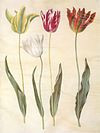
|
||
| Tulipa greigii rule 1873 | Greig tulip | Iran, Central Asia |

|
| Tulipa heweri Raamsd. 1998 | NE Afghanistan | ||
| Tulipa hissarica Popov & Vved. 1935 | Tajikistan, Uzbekistan ( Hissar Mountains ) |

|
|
| Tulipa hoogiana B. Fedsch . 1910 | S Turkmenistan to N Iran | ||
| Tulipa hungarica Borbás 1882 | Hungary, O Serbia, Bulgaria (WZ + S), Greece | ||
| Tulipa iliensis rule 1879 | Kazakhstan, Kyrgyzstan, China (Xinjiang) | ||
| Tulipa ingens Hoog 1902 | Fiery tulip | Tajikistan, Uzbekistan | |
| Tulipa julia K. Koch 1849 | Julia tulip | O Turkey, South Caucasus, Syria, Lebanon | |
| Tulipa kaufmanniana rule 1877 | Water Lily Tulip or Merchant's Tulip | Kazakhstan, Kyrgyzstan, Tajikistan, Uzbekistan |

|
| Tulipa kolpakowskiana rule 1877 | Kazakhstan, Kyrgyzstan, NE Afghanistan, China (NW Xinjiang) | ||
| Tulipa korolkowii rule 1875 | Kazakhstan, Kyrgyzstan, Tajikistan, Uzbekistan | ||
| Tulipa kosovarica Kit Tan, Shuka & Krasniqi 2012 | Kosovo | ||
| Tulipa kuschkensis B. Fedsch . 1932 | Iran, S Turkmenistan, Afghanistan |

|
|
| Tulipa lanata rule 1884 | Woolen tulip | Tajikistan, Uzbekistan, Afghanistan, Pakistan (West Himalaya) | |
| Tulipa lehmanniana Merckl. 1852 | O Iran, Turkmenistan, Kazakhstan, Kyrgyzstan, Tajikistan, Uzbekistan, Afghanistan |

|
|
| Tulipa lemmersii Zonn. 2012 | Kazakhstan | ||
| Tulipa ostrowskiana rule 1884 | Kazakhstan, Kyrgyzstan |

|
|
| Tulipa persica (Lindl.) Sweet 1830 | NW Iran | ||
| Tulipa platystemon Vved. 1935 | Kyrgyzstan | ||
| Tulipa praestans H.B. May 1903 | Excellent tulip | Tajikistan |

|
| Tulipa scardica Bornm. 1923 | S Kosovo to W Greece | ||
| Tulipa sharipovii Tojibaev 2009 | Uzbekistan (Kurama Geb.), Kyrgyzstan ( Chatkal Mountains ) | ||
| Tulipa schmidtii Fomin 1909 | South Caucasus to NW Iran | ||
| Tulipa serbica Tatic & Krivošej 1997 | N Kosovo to SO Serbia | ||
| Tulipa sosnowskyi Achv. & Mirzoeva 1950 | South Caucasus | ||
| Tulipa suaveolens Roth 1794 | Schrenk's tulip | Ukraine, Russia (to South Siberia), Caucasus, Turkey, W Iran, Kazakhstan, Kyrgyzstan |

|
| Tulipa subquinquefolia Vved. 1946 | Tajikistan, Uzbekistan | ||
| Tulipa systola Stapf 1885 | O Turkey, W Iran, Iraq Lebanon, Palestine, Sinai Peninsula |
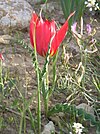
|
|
| Tulipa talassica Lazkov 2011 | Kyrgyzstan, Uzbekistan | ||
| Tulipa tetraphylla rule 1875 | Four-petalled tulip | Kazakhstan, Kyrgyzstan, China (NW Xinjiang) |
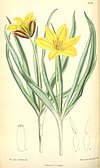
|
| Tulipa ulophylla Wendelbo 1967 | N Iran ( Elbors Mountains ) | ||
| Tulipa undulatifolia Boiss. 1844 | S Balkans, W + Z Turkey, South Caucasus, NE Iran, Turkmenistan, Tajikistan, Uzbekistan | ||
| Tulipa uzbekistanica Embassy . & Sharipov 1971 | S Uzbekistan | ||
| Tulipa vvedenskyi Embassy. 1954 | Tajikistan, Uzbekistan |

|
|
| Subgenus Eriostemones | |||
| Tulipa biflora Pall. 1776 | Two-flowered tulip | Macedonia, Turkey, Crimea, Russia (to Western Siberia), Lebanon, Palestine, Sinai, Saudi Arabia, Iran, Iraq, Afghanistan, Pakistan, China (Xinjiang) |

|
| Tulipa bifloriformis Vved. 1971 | Kazakhstan, Kyrgyzstan, Tajikistan, Uzbekistan |
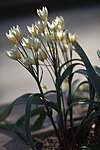
|
|
| Tulipa cinnabarina K. Perss. 2000 | Turkey |

|
|
| Tulipa cretica Boiss. & Hero. 1854 | Greece (Crete) |

|
|
| Tulipa dasystemon rule 1879 | Small star tulip | Central Asia, China (Xinjiang) |

|
| Tulipa humilis Herb. 1844 | Low tulip | Turkey, Caucasus, Iran Iraq, Lebanon, Afghanistan |

|
| Tulipa humilis var. Aucheriana Baker 2013 | O Turkey to Afghanistan |

|
|
| Tulipa humilis var.kurdica Wendelbo 2013 | N Iraq | ||
| Tulipa humilis var.pulchella Fenzl ex Regel 2013 | S + SO Turkey to N Iran |

|
|
| Tulipa kolbintsevii Zonn. 2012 | SO Kazakhstan | ||
| Tulipa koyuncui Eker & Babaç 2010 | SO Turkey | ||
| Tulipa orithyioides Vved. 1935 | Kyrgyzstan, Tajikistan, Uzbekistan | ||
| Tulipa Regelii Krassn. 1888 | SO Kazakhstan |

|
|
| Tulipa saxatilis Sieber ex Spreng. 1825 | Rock Tulip or Crete Tulip | Greece, S Turkey, Aegean Sea, SW Turkey, Crete |

|
| Tulipa sprengeri Baker 1894 | Turkey † (extinguished) |
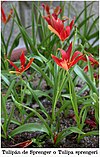
|
|
| Tulipa sylvestris L. 1753 | Wild tulip , vineyard's tulip | Eurasia from Portugal to China (Xinjiang) (neophyte in N, NE, Europe) |

|
| Tulipa sylvestris subsp. australis link 1914 | Mediterranean, N Africa, SZ + E Europe, Caucasus, W Asia, Z Asia, China (Xinjiang) |

|
|
| Tulipa urumiensis Stapf 1932 | Tarda tulip or star tulip | Kazakhstan, Kyrgyzstan, NW Iran |

|
| Tulipa turkestanica rule 1875 | Turkestan tulip | Kyrgyzstan, Tajikistan, Uzbekistan, China (Xinjiang) |

|
| other accepted species | |||
| Tulipa auliekolica Perezhogin 2014 | Kazakhstan | ||
| Tulipa boettgeri rule 1887 | Tajikistan | ||
| Tulipa intermedia Tojibaev & J.de Groot 2014 | Uzbekistan | ||
| Tulipa ivasczenkoa Epiktetov & Belyalov 2013 | Kazakhstan | ||
| Tulipa jacquesii Zonn. 2015 | Kyrgyzstan | ||
| Tulipa orphanidea Boiss. ex hero 1862 | Orphanides tulip | Bulgaria, Greece, Crete, W Turkey |

|
| Tulipa × tschimganica T. dubia × T. kaufmanniana Botschantz. 1961 | Kyrgyzstan, Uzbekistan |

|
|
| Tulipa turgaica Perezhogin 2014 | Kazakhstan | ||
| Tulipa zonneveldii J.de Groot & Tojibaev 2017 | Kyrgyzstan | ||
According to van Raamsdonk, the genus tulips ( Tulipa ) is divided into two sub-genera with several sections.
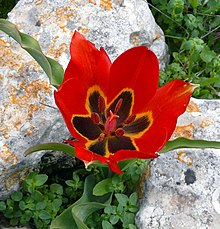






- Subgenus Tulipa : There are five sections:
- Section Clusianae Baker :
- Ladies' tulip ( Tulipa clusiana DC. , Including Tulipa aitchisonii A.D. Hall ): It is common in Iran , northwestern Pakistan and northern India and is a neophyte in southern Europe and Turkey .
- Flax-leaved tulip ( Tulipa linifolia rule ): It is widespread in Central Asia and northern Iran.
- Mountain tulip ( Tulipa montana Lindl. ): It is common in Central Asia and northern Iran.
- Section Kolpakowskianae Raamsd. ex Zonn. & Veldkamp :
- Tulipa altaica Pall. ex explos.
- Tulipa lehmanniana Merckl. : It occurs from eastern Iran to Central Asia.
- Four-petalled tulip ( Tulipa tetraphylla rule ): It is widespread from Central Asia to northwestern Xinjiang .
- Section Tulipanum :
- Tulipanum series :
- Sun-eye tulip ( Tulipa agenensis DC. ): The only home is northwestern Iran. It is a neophyte in southern France and Italy.
- Tulipa aleppensis Boiss. ex rule : It occurs from southern Turkey to Lebanon .
- Julia tulip ( Tulipa julia K. Koch ): It occurs from eastern Turkey to Lebanon and to Transcaucasia.
- Tulipa kuschkensis B. Fedtsch. : It occurs from southern Turkmenistan to Afghanistan .
- Tulipa systola Stapf : It occurs from eastern Turkey to western Iran and the Sinai Peninsula .
- Aureofasciatae Raamsd series . :
- Early tulip ( Tulipa praecox Ten. ): The homeland is unknown. It is a neophyte in southern Europe and western Turkey.
- Tulipanum series :
- Section Eichleres (ADHall) Raamsd. :
- Lanatae Raamsd series . :
- Woolly tulip ( Tulipa lanata rule ), native to: Central Asia, Afghanistan, northeastern Iran
- Fiery tulip ( Tulipa ingens Hoog ): It occurs in Central Asia.
- Eichleres series :
- Tulipa eichleri rule : It occurs from the southern Balkan Peninsula to Turkey and in the eastern Transcaucasia.
- Tubergen tulip ( Tulipa tubergeniana Hoog ): It occurs in Central Asia.
- Foster tulip ( Tulipa fosteriana Irving ): It occurs in Central Asia.
- Vinistriatae Raamsd series .
- Greig tulip ( Tulipa greigii rule ): It occurs in Central Asia.
- Series Undulatae Raamsd.
- Tulipa albertii rule : It occurs in Central Asia.
- Series Luteoapiculatae Raamsd.
- Tulipa sosnovskyi Achv. & Mirzoeva , home: Armenia
- Multiflorae Raamsd series .
- Excellent tulip ( Tulipa praestans Hoog ): It is found in Central Asia.
- Spiranthera series (Vved.) Raamsd.
- Water lily tulip or Kaufmann's tulip ( Tulipa kaufmanniana rule ): It occurs in Central Asia.
- Tulipa tschimganica Botschantz. : It occurs in Central Asia.
- Tulipa dubia Vved. : It occurs in Central Asia.
- Glabrae Raamsd series .
- Tulipa subpraestans Vved. : It occurs in Central Asia.
- Lanatae Raamsd series . :
- Section Tulipa
- Armenian tulip ( Tulipa armena Boiss. ): It occurs from northeastern Turkey to northwestern Iran.
- Tulipa didieri Jord.
- Tulipa gesneriana L. , homeland unknown, is widely cultivated in Europe and is widely naturalized in South and Southwest Asia
- Tulipa hungarica Borbás , homeland: Southwest Romania, Danube, former Yugoslavia
- Tulipa suaveolens Roth , home: Southeast Russia
- Section Clusianae Baker :
- Subgenus Eriostemones (Boiss.) Raamsd.
- Australes Section :
- Tulipa australis Link (Syn .: Tulipa sylvestris subsp. Australis (Link) Pamp. ), Native to: Iberian Peninsula, Balkan Peninsula, Italy, France, Northwest Africa
- Tulipa biebersteiniana Schult. & School f. : It is also used as a synonym for Tulipa sylvestris subsp. australis (Link) Pamp. posed.
- Tulipa hageri hero dr . (Also used as a synonym for Tulipa orphanidea Boiss. ex Heldr. )
- Orphanides tulip ( Tulipa orphanidea Boiss. Ex Heldr. ), Native to: Balkan Peninsula, Aegean Sea, Turkey
- Tulipa primulina Baker : It is also known as the subspecies Tulipa sylvestris subsp. primulina (Baker) Maire & Weiller to Tulipa sylvestris .
- Wild tulip ( Tulipa sylvestris L. ), native to: Europe, Western Asia, naturalized in North Africa and Siberia
- Tulipa whittallii A.D. Hall : It is also used as a synonym for Tulipa orphanidea Boiss. ex hero posed.
- Section Biflores A.D. Hall ex Zonn. & Veldkamp :
- Two-flowered tulip ( Tulipa biflora Pall. ), Native to the Balkan Peninsula, Russia, Crimea, Egypt, the Middle East, Central Asia and western Siberia
- Small star tulip ( Tulipa dasystemon (rule) rule ), Origin: Central Asia, Sinkiang
- Neustrueva tulip ( Tulipa neustruevae Pobed. ), Origin : Central Asia (Fergana)
- Multi-colored tulip ( Tulipa polychroma Stapf )
- Tulipa sogdiana Bunge : It occurs in Central Asia.
- Tarda tulip or star tulip ( Tulipa urumiensis Stapf , Syn .: Tulipa tarda Stapf ): It occurs from northwestern Iran to Central Asia.
- Turkestan tulip ( Tulipa turkestanica rule ): It occurs from Central Asia to northwestern China.
- Saxatiles Section :
- Tulipa aucheriana Baker : It occurs in Syria as well as in Iran.
- Tulipa bakeri A.D. Hall
- Low tulip ( Tulipa humilis Herb. ), Native to: Caucasus region, Iran, Northern Iraq.
- Tulipa pulchella (Rule) Baker . It is also called the variety Tulipa humilis var. Pulchella (Fenzl ex Regel) Christenh by some authors . to Tulipa humilis .
- Rock tulip or Crete tulip ( Tulipa saxatilis Sieber ex Spreng. ): It occurs on islands in the southern Aegean and in western Turkey.
- Australes Section :
Other systematists recognize other types:
- Tulipa akamasica Christodoulou, Hand & Charalambous
- Tulipa albanica Kit Tan & Shuka : It wasfirst describedin 2010 from north-eastern Albania .
- Tulipa auliekolica Perezhogin : It wasfirst describedfrom Kazakhstan in 2014.
- Tulipa cinnabarina K. Perss. : It was first described from Turkey in 2000.
- Tulipa cretica Boiss. & Hero. : This endemic occurs only in Crete.
- Tulipa doerfleri Gand. It is also used as a synonym for Tulipa orphanidea Boiss. ex hero posed.
- Tulipa faribae Ghar., Attar & Ghahrem.-Nejad : It was first described in 2007 and occurs only in the Zāgros Mountains in Iran.
- Tulipa goulimyi Sealy & Turrill : Home: southern Greece.
- Tulipa iliensis rule (Syn .: Tulipa thianschanica rule ): Home: Central Asia to northwestern China.
- Tulipa intermedia Tojibaev & J.de Groot : It wasfirst describedin 2014 in two varieties from Uzbekistan
- Tulipa ivasczenkoae Epiktetov & Belyalov : It was first described from Kazakhstan in 2013.
- Tulipa jacquesii Zonn. : It wasfirst describedfrom Kyrgyzstan in 2015.
- Tulipa kolbintsevii Zonn. : It wasfirst describedin 2012 from southeastern Kazakhstan .
- Tulipa kosovarica Kit Tan, Shuka & Krasniqi : It wasfirst describedfrom Kosovo in 2012.
- Tulipa koyuncui Eker & Babaç : It was first described in 2010 from southeastern Turkey.
- Tulipa lemmersii Zonn., Peterse & J.de Groot : It was first described in 2012 from southern Kazakhstan.
- Tulipa luanica Fadil Millaku & Isa Elezaj
- Mogoltau tulip ( Tulipa mogoltavica Popov & Vved. ). It is also used as a synonym for Tulipa greigii rule .
- Tulipa mongolica Y.Z. Zhao : It was first described in 2003.
- Tulipa sharipovii Tojibaev : It was first described in 2009 from Uzbekistan and Kyrgyzstan.
- Tulipa talassica Lazkov : It was first described from Kyrgyzstan in 2011.
- Tulipa turgaica Perezhogin : It was first described from Kazakhstan in 2014.
- Tulipa zonneveldii J.de Groot & Tojibaev : It was first described from Kyrgyzstan in 2017.
history
The biblical “ Rose of Sharon ” could be a tulip ( Tulipa montana or Tulipa agenensis ). The ancient writers of Greece and Rome did not mention the tulips, although some species are found in the Mediterranean area. They are also absent from Byzantine sources, as there seems to be little overall relationship between Byzantine and Ottoman gardens. In the Middle East, the tulips were cultivated for centuries, with the garden tulip ( Tulipa gesneriana ) probably emerging from several wild species . Possible first parents are Tulipa lanata, Tulipa clusiana, Tulipa aitchisonii, Tulipa stellata and Tulipa armena . Written documents have been in ancient Persian literature since the 9th century. The Turks took over the cultivation of tulips from the Persians. The plant has been mentioned by poets since the 13th century. Tulips were also depicted in miniatures, on ceramics and as clothing samples. They have been used as garden plants since the 16th century at the latest. The preferred shape was lily-shaped with pointed petals. In the " tulip time " ( Lale devrı ) Sultan Ahmed III imported . but also rounded garden tulips from Holland. An illustrated catalog of tulips was published in 1725. Ahmed III. owned famous tulip meadows on the summer pastures (Yayla) in Spil Dağı above Manisa . It is unclear whether these were wild tulips or cultivars.
The garden tulip came to Central and Western Europe from Turkey around the middle of the 16th century. In Italy, tulipa is documented for 1549. The first description comes from the imperial ambassador at the court Suleyman I , Ghislain de Busbecq , who described the tulips in his "Turkish Letters" in 1554. The name he gave, Tulipan (Turkish tülband = turban band), may be based on a linguistic misunderstanding (naming the shape, not the plant) or on a Turkish folk name of the plants. In written language, the tulips were called lalé in Turkish and in Persian . Busbecq probably sent among the recorded seeds and bulbs also those of tulips to Vienna, there is evidence of a picture of the tulip under the name Narcissus by Pietro Andrea Mattioli in 1565. Conrad Gessner made a picture of a tulip in 1561, which he had in the garden of councilor Heinrich Herwart in 1559 had seen in Augsburg. It should have been Tulipa armena or a cultural form of this kind. Gessner's description served as the basis for the description of Tulipa gesneriana by Carl von Linné in 1753. The first more detailed work on tulips was done by Carolus Clusius , who traded tulips in large parts of Europe arrived. Towards the end of the 16th century, Holland became a center of onion plants, especially tulips. A large number of varieties emerged, including those with double flowers or with colored, flamed flowers, which was caused by a viral disease. The tulips became an object of speculation in upscale Western European circles, the so-called tulip mania arose until the market value of tulips normalized again after a stock market crash in 1637. In the decades after the tulip mania, the tulip developed from a flower of the nobility and middle class to a widespread ornamental plant.
In the well-known hymn by Paul Gerhardt go out, my heart, and search for Freud it says in the 2nd verse:
Narcissus and the Tulipan
They dress much nicer
than Solomonis silk
At the end of the 19th century, the targeted breeding of new varieties developed in the Netherlands, so in 1885 the tall, late-blooming Darwin tulips came onto the market. The Triumph tulips, which now make up the majority of all variety groups, were created by crossing earlier, short-stemmed tulips with Darwin and Breeder tulips. For example, lily-flowered tulips were created by crossing Tulipa retroflexa .
In the winter of 1944-45 in was Netherlands especially the densely populated Holland hunger affected. Among other things, the tulip was then used as a substitute food . The Hongerwinter was a disaster that began towards the end of World War II in the Dutch territories occupied by German troops in October 1944. The supply improved only after the armistice of Achterveld on April 30, 1945. A ban by the German Reich Commissioner for the Netherlands Seyß-Inquart to the use of inland waterways for the transport of food and fuel had previously caused the population not to be supplied with food and fuel could be supplied from the more rural regions. As a result, 4.5 million people there were affected by undersupply. The number of people who died as a result of this famine is estimated at 18,000 to 22,000.
People were increasingly consuming raw materials that had not previously been used in human nutrition. First sugar beets were processed, later also flower bulbs. Eating tulip bulbs had a special background. The western Netherlands was cut off from the rest of Europe. The export of tulip bulbs had come to a standstill, so large quantities were in stock. After Dutch doctors declared that the bulbs were safe to eat, tulip growers sold them as food. There were special instructions for preparation in order to make use of the high starch content of the onions. The taste of these tulip bulbs - compared to that of the sugar beet - was so unusual that it was talked about a lot. The tulip later became the symbol of the hungry winter. This is mainly due to the imagery: the tulip was the Dutch product at the time.
From the end of April 1945, in the so-called Manna and Chowhound operations, the Allies carried out supply flights over the occupied territory for ten days , for which a temporary and geographically limited armistice could previously be negotiated with the German Reich Commissioner. A photo was taken from one of these planes, showing how people thanked them with blooming tulips.

use
The garden tulips were grown from the wild tulips. Several thousand cultivars have emerged from the wild tulips within 400 years. Tulips appreciate moisture in spring, hot, dry locations on nutrient-rich soils with a pH value of 6.5 to 7.0 in summer (this is the best way for bulbs to ripen), and need cooler nights and cold winters to thrive.
The Netherlands is the world's largest producer of tulips. In Germany , tulips are produced in the Lower Rhine region , especially in the Neuss district .
Tulip varieties are important ornamental plants , both as garden plants and as cut flowers. Over 80% of the world's tulip production comes from the Netherlands . Over 1200 varieties are cultivated here, but the 40 most common varieties take up more than half of the area under cultivation. Of the more than 9500 hectares of cultivation area in the Netherlands, over 90% is accounted for by Tulipa gesneriana , the rest mainly by Tulipa kaufmanniana , Tulipa greigii , and Tulipa fosteriana .
Tulips do not play a role in medicine or medicine. They are even toxic to humans and animals (e.g. horses, dogs and cats as well as rodents). The tulipanin contained in onions and sprouts causes vomiting, stomach cramps, stomach and intestinal problems, among other things.
Multiplication
Tulips can be propagated generatively using seeds or vegetatively using daughter bulbs. In summer, daughter onions grow on the large mother onions, which are "cleared" (dug up and separated) in early autumn. They are replanted before the first frost in the ground and form larger bulbs in the coming year. Tulip bulbs require the cooling phase of winter or artificial cooling ( vernalization ) to form flowers . Obtaining flowering onions from seeds is much more time-consuming than from daughter onions. In addition, the plants raised from seeds have different properties (e.g. flower color) than the original variety.
Cultivated tulips
The tulips are divided into 15 groups of varieties. Groups 12 to 15 include wild tulips and their hybrids.
- Simple early (Duc-van-Tol-Tulips): They reach heights of growth of 25 to 35 centimeters. The flowering time is in April. They are used for summer discounts, as cut flowers and from December for forcing.
- Filled mornings: They reach heights of 8 to 35 centimeters. The flowering time is in April. The diameter of the flowers reaches up to 10 centimeters. They are used for summer discounts, as cut flowers and from December for forcing.
- Triumph Tulips (Simple Early × Darwin and Cottage Tulips): They reach heights of growth of 30 to 40 (50) centimeters. The flowering time is at the beginning of May. They are used as cut flowers and for forcing from December to January.
- Darwin hybrids: (Darwin tulips × Tulipa fosteriana ): They reach heights of growth of 30 to 70 centimeters. The flowering period is from the end of April to the middle of May. The flowers are very large. Often there is a black basal spot with a yellow border. They are used as cut flowers and for forcing.
- Simple late ones (this is where the Darwin and Cottage tulips belong, these were previously managed as a separate group): They reach heights of 40 to 70 centimeters. The flowering time is in May. The stems are robust. The flowers are firm, look almost angular when viewed from the side and can be of any color. They are used as cut flowers, some varieties from January also for forcing.
- Lily-flowered: They reach heights of 30 to 50 centimeters. The bracts are narrow, curved outwards and taper off in a long point. The stem is often not firm enough. The flowers can be of any color. They are especially used as cut flowers.
- Fringed tulips: The edges of the bracts are irregularly fringed to jagged. The fringes are often white. They are used as cut flowers.
- Viridiflora group (green-flowered): They reach heights of growth of 25 to 60 centimeters. The bracts are more or less pale green, the edge is yellowish to white and pointed. They are used as cut flowers.
- Rembrandt tulips: The bracts have a stripe, spot or feather pattern ("broken"), they are purple, pink, red, bronze or brown in color, on a white, red or yellow background (viroses). The flowering time is in the 2nd half of May. They are used as cut flowers.
- Parrot tulips: They reach heights of 20 to 60 centimeters. The flowers are large. The bracts are incised, fringed, mostly flamed and spotted. They were grown from Darwin tulips and other late tulips in the 17th century. Some of the stems are too weak, but this is no longer the case with newer varieties. They are used as cut flowers.
- Double late (peony tulips): They reach heights of 40 to 60 centimeters. The flowers are usually red, pink, yellow or multicolored. The flowering period is from mid-May. They are sensitive to rain and wind and are used as cut flowers.
- Kaufmanniana tulips: They reach heights of 10 to 25 Centimeter. The flowering time is in March. The flowers are broadly bell-shaped to star-shaped and creamy white, dark yellow or salmon pink; crosses with Tulipa greigii can be red. The basal spot is usually yellow. They are considered to be more resistant than other wild tulips from Central Asia.
- Fosteriana tulips: They reach heights of 20 to 30 centimeters. The flowers are up to 15 centimeters long. The leaves reach sizes up to 30 × 16 centimeters. The flowering time is at the beginning of April.
- Greigii tulips: They reach heights of 20 to 30 centimeters. The flowers are purple to scarlet in color. The basal spot is black and has a yellow border. The flowering time is in April. The leaves are usually mottled purple-brown.
- Other tulips: The remaining wild tulips.
symbolism
In literature and the performing arts, the tulip can stand for transience , in the " flower language " on the other hand for love and affection. A multitude of other meanings are circulating in everyday use and on the Internet, ranging from “symbol of spring” to “symbol for the Netherlands” to “symbol for Parkinson's disease ” (for the red tulip).
swell
- MJM Christenhusz, Rafaël Govaerts, JC David, T. Hall, K. Borland, PS Roberts, A. Tuomisto, S. Buerki, MW Chase, MF Fay: Tiptoe through the tulips - cultural history, molecular phylogenetics and classification of Tulipa (Liliaceae ). In: Botanical Journal of the Linnean Society. Volume 172, 2013, pp. 280-328.
- Gerald B. Straley, Frederick H. Utech: Tulipa. P. 199 - same text online as the printed work , In: Flora of North America Editorial Committee (Ed.): Flora of North America North of Mexico. Volume 26: Magnoliophyta: Liliidae: Liliales and Orchidales , Oxford University Press, New York and Oxford, 2002, ISBN 0-19-515208-5 .
- Chen Xinqi, Helen V. Mordak: Tulipa , pp. 123–126 - online with the same text as the printed work, In: Wu Zheng-yi, Peter H. Raven (ed.): Flora of China. Volume 24: Flagellariaceae through Marantaceae. Science Press and Missouri Botanical Garden Press, Beijing and St. Louis 2000, ISBN 0-915279-83-5 .
- Walter Erhardt , Erich Götz, Nils Bödeker, Siegmund Seybold: The great pikeperch. Encyclopedia of Plant Names. Volume 2. Types and varieties. Eugen Ulmer, Stuttgart 2008, ISBN 978-3-8001-5406-7 .
- C. Gray-Wilson, VA Matthews: Tulipa L. In: Thomas Gaskell Tutin et al .: Flora Europaea. Volume 5, Cambridge University Press 1980, ISBN 0-521-20108-X , pp. 28-31.
further reading
- Mike Dash : Tulip madness. The craziest speculation in history. (Original title: Tulipomania, translated by Elfriede Peschel). Claassen Verlag, 1999, ISBN 3-546-00177-X .
- Anna Pavord: The tulip . A cultural history (original title: The Tulip. Translated by Sven Däne and Thomas Wollermann). Insel , Frankfurt am Main / Leipzig 2003, ISBN 3-458-16979-2 .
- Richard Wilford: Tulips: Species and Hybrids for the Gardener. Timber Press, Portland London 2006, ISBN 0-88192-763-5 .
- Sinaida Petrovna Botschantzewa: Tulips: Taxonomy, Morphology, Cytology, Phytogeography and Physiology. translated and edit HQ Varekamp, Balkema, Rotterdam 1982, ISBN 90-6191-029-3 . ( Google Books )
- Maarten JM Christenhusz, Rafaël Govaerts, John C. David, Tony Hall, Katherine Borland, Penelope S. Roberts, Anne Tuomisto, Sven Buerki, Mark W. Chase, Michael F. Fay: Tiptoe through the tulips - cultural history, molecular phylogenetics and classification of Tulipa (Liliaceae). In: Botanical Journal of the Linnean Society. Volume 172, Issue 3, 2013, pp. 280-328. doi: 10.1111 / boj.12061 .
Web links
- Little tulip customer .
- Karlsruhe tulip books in the digital collections of the Baden State Library
Individual evidence
- ↑ Helmut Genaust: Etymological dictionary of botanical plant names. 3rd, completely revised and expanded edition. Birkhäuser, Basel / Boston / Berlin 1996, ISBN 3-7643-2390-6 , p. 664.
- ↑ Wolfgang Pfeifer: Etymological Dictionary of German. Deutscher Taschenbuch Verlag, 1997; Lemma tulip
- ↑ Thomas Barth, Karl Weinhausen, Heinrich Pape: The culture of bulbs and tubers. Parey, Berlin 1954, p. 24.
- ↑ a b c d e f g h i j k l m n o p q r s t u v w x y z aa ab ac ad ae af ag ah ai aj ak al am an ao ap aq ar as at au av aw Rafaël Govaerts (Ed.): Tulipa. In: World Checklist of Selected Plant Families (WCSP) - The Board of Trustees of the Royal Botanic Gardens, Kew . Retrieved July 3, 2018.
- ^ Manfred A. Fischer , Karl Oswald, Wolfgang Adler: Excursion flora for Austria, Liechtenstein and South Tyrol. 3rd, improved edition. State of Upper Austria, Biology Center of the Upper Austrian State Museums, Linz 2008, ISBN 978-3-85474-187-9 .
- ↑ Chen Xinqi, Helen V. Mordak: Tulipa , pp. 123–126 - online with the same text as the printed work, In: Wu Zheng-yi, Peter H. Raven (ed.): Flora of China. Volume 24: Flagellariaceae through Marantaceae. Science Press and Missouri Botanical Garden Press, Beijing and St. Louis 2000, ISBN 0-915279-83-5 .
- ↑ a b LWD van Raamsdonk, W. Eikelboom, T. de Vries: The systematics of the genus Tulipa L. In: Acta Horticulturae. Volume 430, 1997, pp. 821-828.
- ↑ Maarten JM Christenhusz, Rafaël Govaerts, JC David, T. Hall, K. Borland, PS Roberts, A. Tuomisto, S. Buerki, MW Chase, MF Fay: Tiptoe through the tulips - cultural history, molecular phylogenetics and classification of Tulipa (Liliaceae). In: Botanical Journal of the Linnean Society, Volume 172, 2013, pp. 280-328, doi: 10.1111 / boj.12061 .
- ↑ Ismail Eker, Babaç Mehmet Tekin Mehmet Koyuncu: “Revision of the genus Tulipa L. (Liliaceae) in Turkey”, Phytotaxa 29 January 2014, volume = 157, issue = 1, pages = 1–112; doi: 10.11646 / phytotaxa.157.1.1
- ^ R. Govaerts, J. Dransfield, S. Zona, DR Hodel & A. Henderson (2019). World Checklist of Tulipa. Royal Botanic Gardens, Kew. Published on the Internet; apps.kew.org ; Accessed January 13, 2019.
- ↑ LWD van Raamsdonk, T. de Vries: Species relationships and taxonomy in Tulipa subg. Tulipa (Liliaceae). In: Plant Systematics and Evolution. Volume 195, 1995, pp. 13-44.
- ↑ LWD van Raamsdonk, T. de Vries: Biosystematic studies in Tulipa sect. Eriostemones (Liliaceae). In: Plant Systematics and Evolution. Volume 179, 1992, pp. 27-41.
- ↑ A. Ghahreman, F. Attar, F. Ghahremaninejad: A New Species of Tulipa (Liliaceae) from Western Iran. In: Novon: A Journal for Botanical Nomenclature. Volume 17, No. 4, 2007, pp. 437-439 ( abstract )
- ↑ Fadil Millaku, Isa Elezaj: Tulipa luanica (Liliaceae), a New Species from Southern Kosovo . Annales Botanici Fennici, Volume 52, Issue 5-6, pp. 315-320 doi: 10.5735 / 085.052.0506
- ^ YZ Zhao: A New Species of the Genus Tulipa (Liliaceae) from China. In: Novon: A Journal for Botanical Nomenclature. Volume 13, No. 2, 2003, pp. 277–278 (online)
- ^ John H. Harvey: Turkey as a Source of Garden Plants. In: Garden History. 4, 3, 1976, p. 22. JSTOR 1586521
- ↑ Liz Dobbs: Tulip. Quadrille, London 2004, p. 5.
- ↑ Liz Dobbs: Tulip. Quadrille, London 2004, p. 6.
- ^ John H. Harvey: Turkey as a Source of Garden Plants. In: Garden History. 4, 3, 1976, p. 22. JSTOR 1586521
- ^ Ogier Ghislain de Busbecq: Legationis Turcicae Epistolae quatuor. Epistola great. 1595, p. 33 , accessed December 26, 2015 (Latin).
- ↑ Liz Dobbs: Tulip. Quadrille, London 2004, p. 5.
- ↑ The history section is based on: Heinz-Dieter Krausch : Kaiserkron and Peonies red ... From the discovery and introduction of our garden flowers. Deutscher Taschenbuch Verlag, Munich 2007, ISBN 978-3-423-34412-8 , pp. 471-477.
- ^ David Barnouw: The Netherlands in World War II. P. 96.
- ^ Rolf-Dieter Müller: At the side of the Wehrmacht: Hitler's foreign helpers in the "crusade against Bolshevism". S. 142. 2007, Ch. Links Verlag, Fischer Taschenbuch 2010.
- ^ David Barnouw: The Netherlands in World War II. P. 96.
- ↑ Eating Tulip Bulbs During World War II. In: amsterdamtulipmuseumonline.com . September 25, 2017 (English).
- ↑ Silke Wortel: Famine. In: The History of the Netherlands 1940-1945. Westfälische Wilhelms-Universität, June 2007, accessed on June 26, 2017 .
- ↑ Marcel Le Nard: Tulipe: biodiversité et sélection. In: S. Le Perchec, P. Guy, A. Fraval (eds.): Agriculture et biodiversité des plantes. Dossiers de l'Environnement de l'INRA n ° 21. Paris 2001, pp. 105-111. (online) (PDF; 389 kB).
- ↑ tulip. "Medicinal Effects and Medical Use", "Toxins, Effects and Symptoms". In: Botanikus. Uwe Lochstampfer, accessed on April 23, 2018 .
- ^ Andreas Bettin: Cultivation techniques in ornamental plant cultivation. Ulmer, 2011, ISBN 978-3-8001-5187-5 .
- ^ Eckehart J. Jäger, Friedrich Ebel, Peter Hanelt, Gerd K. Müller (eds.): Rothmaler Exkursionsflora von Deutschland. Volume 5: Herbaceous ornamental and useful plants. Spectrum Academic Publishing House, Berlin / Heidelberg 2008, ISBN 978-3-8274-0918-8 .
- ↑ Carolin Catharina Wolf: Pictures of transience in the poetry of Andreas Gryphius. Grin Verlag, 2004, ISBN 3-638-82236-2 , pp. 7–8 (books.google.com)
- ↑ Parkinson's tulip . Website of Parkinson's Self-Help Austria. Retrieved September 27, 2018.







